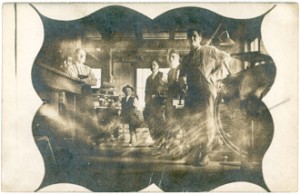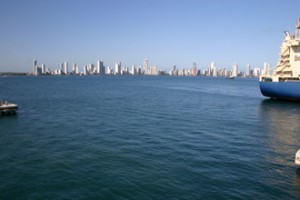This past weekend I was immersed in the unpleasant chore of paying bills, when I reached for a pen and instead, my clumsy grasp sent a cup full of pens spilling over the edge of my desk and into a box full of old cards. Reluctantly, I got up out of my chair and fumbled through the box, my eyes landing on some old photos stored in a clear plastic box.
 Upon seeing the fading image my grandfather as head pressman of the print shop where he worked, I realized I had not scanned the photo, which I thought might make a good retouching project for my Photoshop students.
Upon seeing the fading image my grandfather as head pressman of the print shop where he worked, I realized I had not scanned the photo, which I thought might make a good retouching project for my Photoshop students.
And then, much as I hated to, I had to stop myself from wandering off track, but when I saw this new 180-degree panorama image juxtaposed with the circa 1920 image of my grandfather, I couldn’t help but marvel at the technology built into our mobile devices.
As I mentioned in my article on “grunge” apps, now that we’ve mastered the doctored image to near perfection, we’ve gone on to mimic effects like the vignette, the scratches, and the light leaks in this aged image. And now we can create 180-degree, 360-degree, and even cave-like images projections that totally surround.
As a kid growing up in the 50s, the Dick Tracy watch was science fiction. Who’d thunk that as an adult, I’d have my very own communication device far superior to anything Dick ever imagined? This week I’m into panorama apps, but note that this is not intended as a review or comparison of specific applications, but instead, a reflection of my limited experiences with panorama apps in general.
 Typically, if you’re shooting with a normal lens, you can achieve a panorama effect by cropping and zooming into a very narrow area of an image. That’s essentially what you get when you order a panorama from the drug store, or your local film processor.
Typically, if you’re shooting with a normal lens, you can achieve a panorama effect by cropping and zooming into a very narrow area of an image. That’s essentially what you get when you order a panorama from the drug store, or your local film processor.
Among its many automation features, Photoshop has a fairly sophisticated blending function called “photomerge.” These days, however, I’m into “quick and dirty,” but I don’t really see the “dirty” in an app like AutoStitch from Cloudburst Research. It’s incredibly simple to use and has impressive blending and exposure algorithms.
 I’ve been making images around the college campus where I teach, and one of the effects when shooting these panoramas that has intrigued me ever since I studied photography is that of the disappearing people. I’ll never forget the sense of awe I experienced when seeing the photographs of Ralph Eugene Meatyard. The children in the images had disappearing faces, an effect all photographers have experienced when using slow shutter speeds while the subject moves.
I’ve been making images around the college campus where I teach, and one of the effects when shooting these panoramas that has intrigued me ever since I studied photography is that of the disappearing people. I’ll never forget the sense of awe I experienced when seeing the photographs of Ralph Eugene Meatyard. The children in the images had disappearing faces, an effect all photographers have experienced when using slow shutter speeds while the subject moves.
It’s one of those things that started me thinking about how untrustworthy human vision is, and the fact that we don’t see something doesn’t necessarily mean it is not there. It just means that our senses are not acute enough…and you can extrapolate whatever you want from that. My next project is to turn some of these panoramas into bookmarks that I can include with the gifts I give during the coming year.


